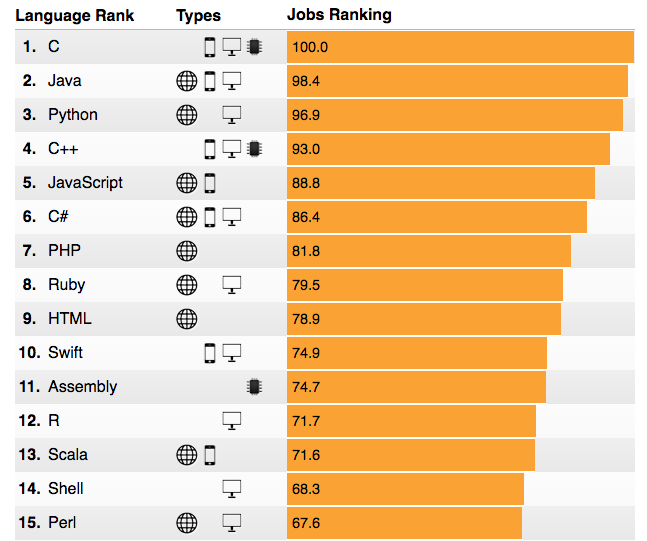
Curious about how nonprofits and other organizations generate their lists of the world’s most popular programming languages?
With its latest programming rankings, IEEE Spectrum provides a bit of glimpse into how the proverbial sausage is made. The IEEE Spectrum rankings
combine data from 10 different sources, including job postings, social chatter, and open-source code production. Starting with a list of 300 programming languages taken from GitHub, the organization’s analysts use everything from Twitter and Google Trends to Hacker News and Reddit to create a refined inventory of 48 languages. Unlike other programming-language rankings that unify variables into a single list, IEEE Spectrum breaks out the various weightings into discrete tables. For example, if you want to see which language is most in-demand by employers, that data is available to you; so is a ranking of languages most popular on open-source hubs, languages with the highest rate of growth, and so on. Thanks to its unique methodology, IEEE Spectrum’s rankings are different than those produced by, say, RedMonk or TIOBE. For example, JavaScript, Java, and PHP dominated
RedMonk’s mid-year list of the top-trending programming languages, while Java, C, C++, and Python head up the
most recent iteration of TIOBE’s monthly ranking. By comparison, C, Java, Python, and C++ top IEEE Spectrum’s list, with C taking top rank in the employer-demand and growth categories; C++ dominates the open-source popularity ranking. Here are the top languages for employer demand:

Why does the same handful of languages dominate rankings with wildly different methodologies? Thousands of programmers use those languages for hundreds of thousands of websites and applications, embedding them firmly in our modern tech infrastructure. Once these languages are ubiquitous, they’re hard to dislodge. New languages, on the other hand, can take years to creep slowly up the rankings; even Swift, Apple’s next-generation language for programming in iOS and Mac OS X, has struggled to eclipse its predecessor, Objective-C, despite an aggressive marketing push from Apple. What does this mean for tech pros? Familiarity with the top programming languages can only benefit your career—but pay attention to fast risers like Swift, which could seize more of the industry’s mind-share in coming years.
 Curious about how nonprofits and other organizations generate their lists of the world’s most popular programming languages? With its latest programming rankings, IEEE Spectrum provides a bit of glimpse into how the proverbial sausage is made. The IEEE Spectrum rankings combine data from 10 different sources, including job postings, social chatter, and open-source code production. Starting with a list of 300 programming languages taken from GitHub, the organization’s analysts use everything from Twitter and Google Trends to Hacker News and Reddit to create a refined inventory of 48 languages. Unlike other programming-language rankings that unify variables into a single list, IEEE Spectrum breaks out the various weightings into discrete tables. For example, if you want to see which language is most in-demand by employers, that data is available to you; so is a ranking of languages most popular on open-source hubs, languages with the highest rate of growth, and so on. Thanks to its unique methodology, IEEE Spectrum’s rankings are different than those produced by, say, RedMonk or TIOBE. For example, JavaScript, Java, and PHP dominated RedMonk’s mid-year list of the top-trending programming languages, while Java, C, C++, and Python head up the most recent iteration of TIOBE’s monthly ranking. By comparison, C, Java, Python, and C++ top IEEE Spectrum’s list, with C taking top rank in the employer-demand and growth categories; C++ dominates the open-source popularity ranking. Here are the top languages for employer demand:
Curious about how nonprofits and other organizations generate their lists of the world’s most popular programming languages? With its latest programming rankings, IEEE Spectrum provides a bit of glimpse into how the proverbial sausage is made. The IEEE Spectrum rankings combine data from 10 different sources, including job postings, social chatter, and open-source code production. Starting with a list of 300 programming languages taken from GitHub, the organization’s analysts use everything from Twitter and Google Trends to Hacker News and Reddit to create a refined inventory of 48 languages. Unlike other programming-language rankings that unify variables into a single list, IEEE Spectrum breaks out the various weightings into discrete tables. For example, if you want to see which language is most in-demand by employers, that data is available to you; so is a ranking of languages most popular on open-source hubs, languages with the highest rate of growth, and so on. Thanks to its unique methodology, IEEE Spectrum’s rankings are different than those produced by, say, RedMonk or TIOBE. For example, JavaScript, Java, and PHP dominated RedMonk’s mid-year list of the top-trending programming languages, while Java, C, C++, and Python head up the most recent iteration of TIOBE’s monthly ranking. By comparison, C, Java, Python, and C++ top IEEE Spectrum’s list, with C taking top rank in the employer-demand and growth categories; C++ dominates the open-source popularity ranking. Here are the top languages for employer demand:  Why does the same handful of languages dominate rankings with wildly different methodologies? Thousands of programmers use those languages for hundreds of thousands of websites and applications, embedding them firmly in our modern tech infrastructure. Once these languages are ubiquitous, they’re hard to dislodge. New languages, on the other hand, can take years to creep slowly up the rankings; even Swift, Apple’s next-generation language for programming in iOS and Mac OS X, has struggled to eclipse its predecessor, Objective-C, despite an aggressive marketing push from Apple. What does this mean for tech pros? Familiarity with the top programming languages can only benefit your career—but pay attention to fast risers like Swift, which could seize more of the industry’s mind-share in coming years.
Why does the same handful of languages dominate rankings with wildly different methodologies? Thousands of programmers use those languages for hundreds of thousands of websites and applications, embedding them firmly in our modern tech infrastructure. Once these languages are ubiquitous, they’re hard to dislodge. New languages, on the other hand, can take years to creep slowly up the rankings; even Swift, Apple’s next-generation language for programming in iOS and Mac OS X, has struggled to eclipse its predecessor, Objective-C, despite an aggressive marketing push from Apple. What does this mean for tech pros? Familiarity with the top programming languages can only benefit your career—but pay attention to fast risers like Swift, which could seize more of the industry’s mind-share in coming years. 


